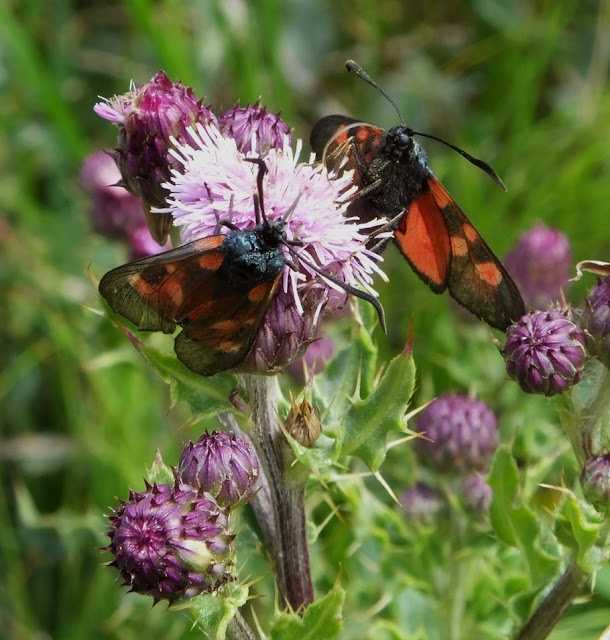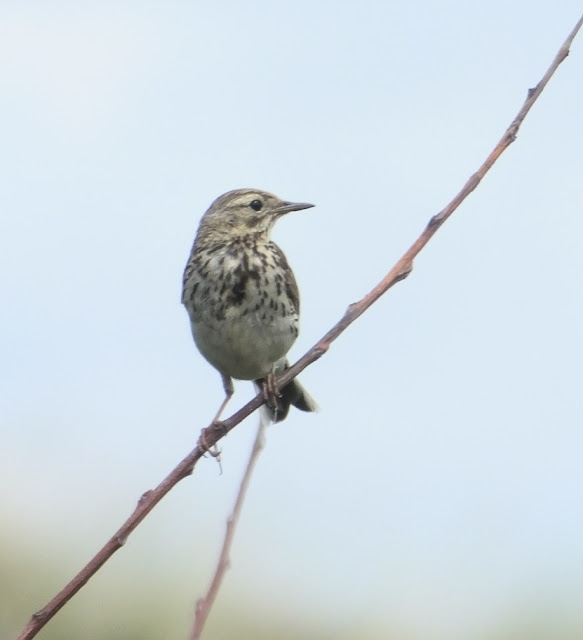The Safari had built up a big surplus of extra hours and even after booking some flexi-time for a long weekend we still had a a few to play with. Yesterday mornig we got a txt from Young Un AB saying he'd just been on the dunes and counted a very accurate 841 Pyramidal Orchids and seen a Grayling butterfly - that was excuse enough for a very long lunch break.
As soon as we arrived on site we saw there were lots of Burnet moths everywhere, almost every Creeping Thistle flowerhead had at least one supping away at the nectar within.
All the ones we looked at closely, without our specs we might add, were Narrow Bordered 5-spot Burnets.
Walking a few yards further into the dunes we disturbed a Meadow Pipit that wasn't at all happy with our presence
It kept a rather watchful eye on us.
But where were all those orchids? Another couple of steps and we crested a small rise and there amid the Creeping Willow were several pink flower spikes, about 20of them, not the mother lode but a good start.
They were growing in an area from which much invasive Sea Buckthorn had been removed during the winter, the management certainly appeared to suit them.
AB was kind enough to tell us the whereabouts of other orchids nearby too which included Common Twayblade which we didn't know grew on the site, surely we'd been told at some stage over the last 25 years or so and forgotten if that was the case the information certainly wasn't for being retrieved from our memory banks!
Only a few yards away near a large hole that is being dug for an as yet unknown reason, probably to provide some form of dune slack (aka seasonally wet area), he said there were some Marsh Helleborines.
From there he directed us across the road to look into the garden of the rest-home which has been left uncut and is a wondrous array of colours from the multitude of wildflowers growing in the short sand turf, it is a sight to behold! The target here was probably the most dull and insignificant looking plant in the 'meadow' but one of the rarest in the country/world being an endemic to a handful of scattered sites around the coast and not overly numerous at any of them, the rather wishy-washy nondescript looking Dune Helleborine.
We didn't have permission to enter the garden but saw one of the five specimens not too far away from the wall.
Exciting isn't it! Well it's not a looker but it is pretty special.
Walking back to the Land Rover (we keep threatening to replace it, but can we part with it?) a small orangy butterfly flew across the track in front of our knees, a Gatekeeper - one of the species we looked for unsuccessfully at the White Letter Hairstreak site at the weekend. They'll probably be out in force there this coming weekend if the warm(ish) sunny weather holds.
Not a bad way to spend a lunch hour and a bit.
Back in the office walking along the corridor we spotted a tiny bee that hadn't been able to find an open window and succumbed to the heat - yes we look at all manner of strange things! The thing that grabbed our attention was the red underside to its abdomen, not seen one like that before so in a pot it went, but what exactly was it? Why a pot for a dead bee - habit we suppose!
A plea on Twitter was made and the very knowledgeable and very modest @RyanClarkNature cme back with a name Megachile centuncularis, a quick look on the national database showed it to be, unsurprisingly, the first record for town and only the second for the whole of the Fylde (with the proviso that the NBN maps can be a little behind the times)/
Our last late finish of the season was helping an enthusiastic gang of Rainbows do some mini-beast hunting and pond dipping. Our best find for them was a Zebra Spider just before the action kicked off.
 |
| A quick little devil that didn't like being in the light in the middle of the lid of the pot |
Better but stiller in the bright sunshine
Today we had a pretty intense time at work but were able to finish early and meet up with AB on the dunes and he showed us some of the other specialities he'd learned about from the old master MJ.
There's some nice moths on the dunes, we saw Latticed Heath but it was too quick for the lens unlike this Blackneck which did its best to hide from us.
It's larvae feed on Tufted Vetch of which there is plenty on the reserve. Nowhere near as common locally is Cotton Grass, a species more normally thought of as upland bog plant but was probably very common on the lowland mosses before they were extensively drained. A nearby field which had a sizeable colony was drained for a sports field not too many years ago.
Another orchid species here is Early Marsh Orchid, its earliness now meaning it's coming to the end of its season and most of them were going well over.
Harebells were everywhere, don't think we've ever seen so many here. the floral display this summer is really fine and well worth a visit.
Like the Cotton Grass they were blowing around a bit
AB shifted up a gear after spotting another speciality moth, seconds later his bag was off his bag and a pot removed and de-lidded. in a jiffy a Silver Hook was inside. A new one for us and what a little beauty.
This one's a sedge feeder.
He released it but it wouldn't settle in the right place for a pic. While trying to get the pic we saw a shield bug. It's a still a nymph and we're not sure which species.
There are areas of the dunes that are losing their spectacular wildflowers to longer denser grassland. Some management has been begun to address this but really what's needed is more Rabbits to graze it down. There are some but not enough and they're widely scattered across the reserve and not able to 'control' large areas of dense vegetation. One thing is for sure they don't like Thyme!
On the final way back to the Land Rover we got the pic we wanted, OK very nearly the pic we wanted
We'd have preferred a more contrary Small Skipper but you can't have everything and it was a brilliant hour out all thanks to AB.
Where to next? Anything could happen tomorrow.In the meantime let us know what unknowns who's keeled over in your outback.





























2 comments:
Crikey Dave, what a lunch break that was. Love the burnets on the thistles - there were lots at the mere yesterday too, along the embankment but they were blowing about wildly so were a real struggle to photograph. Likewise numerous Gatekeepers at the mere, outnumbering the Meadow Browns! The Blackneck & Silver Hook are cracking finds, never heard of either before. The dunes is somewhere I never think to visit, must give it a go sometime.
Hi this is very useful post for everyone. Thank you so much this post. Just about everything looks good displayed. Domestic tour packages
Post a Comment